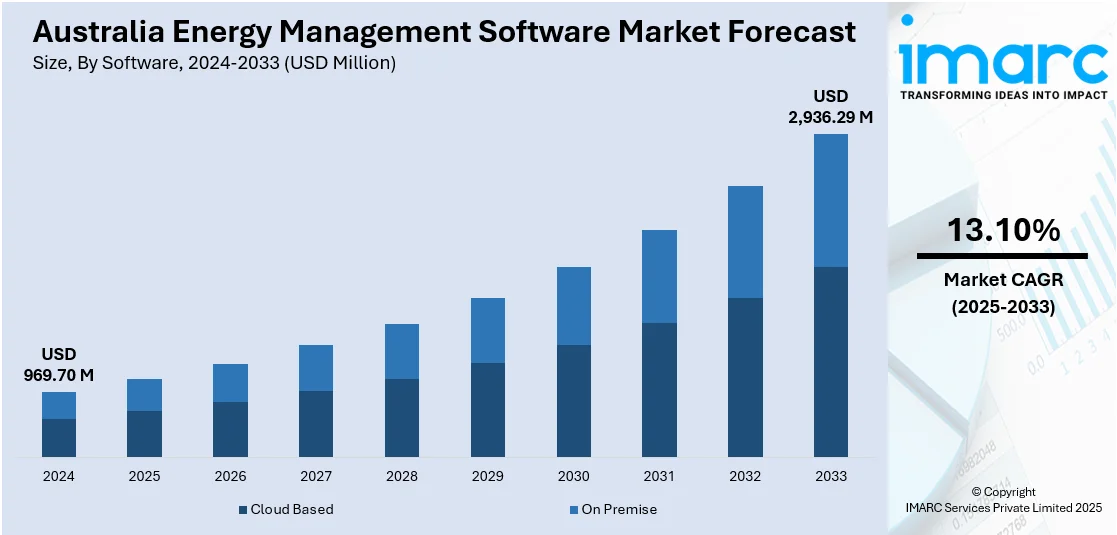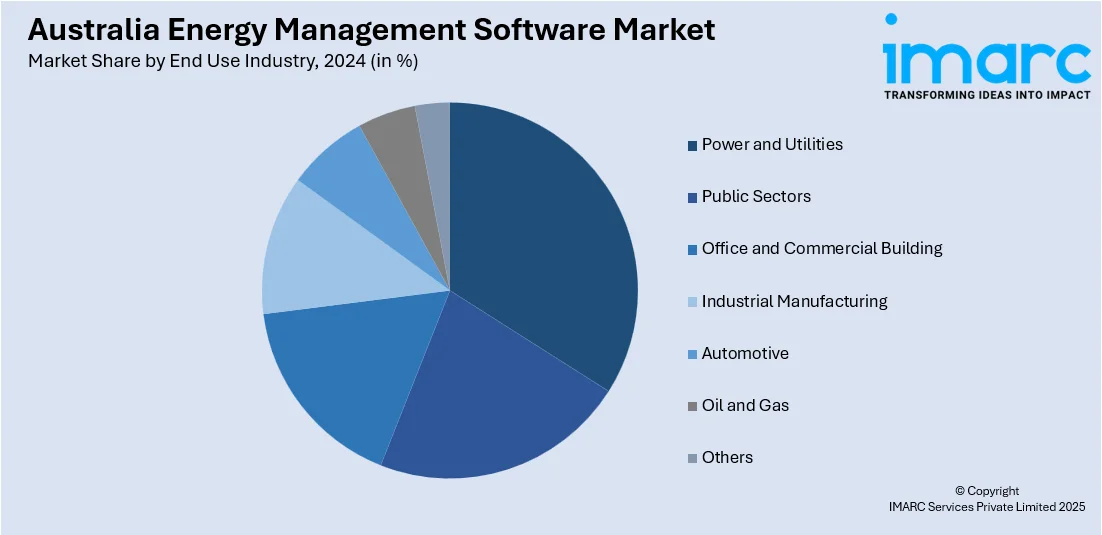
Australia Energy Management Software Market Size, Share, Trends and Forecast by Software, Solution, End Use Industry, and Region, 2025-2033
Australia Energy Management Software Market Overview:
The Australia energy management software market size reached USD 969.70 Million in 2024. Looking forward, IMARC Group expects the market to reach USD 2,936.29 Million by 2033, exhibiting a growth rate (CAGR) of 13.10% during 2025-2033. At present, Australia is experiencing growth because industries and organizations are constantly searching for means to minimize energy consumption. This, along with the implementation of regulations that encourage energy-efficient technologies via policy, incentives, and legislation, is propelling the market growth. Moreover, improvements in Internet of Things (IoT) devices and smart technology is expanding the Australia energy management software market share.
|
Report Attribute
|
Key Statistics
|
|---|---|
|
Base Year
|
2024
|
|
Forecast Years
|
2025-2033
|
|
Historical Years
|
2019-2024
|
| Market Size in 2024 | USD 969.70 Million |
| Market Forecast in 2033 | USD 2,936.29 Million |
| Market Growth Rate 2025-2033 | 13.10% |
Australia Energy Management Software Market Trends:
Growing need for energy savings and cost reduction
The energy management software demand is increasing in Australia because industries and organizations are constantly searching for means to minimize energy consumption. The organizations are looking to adopt energy-efficient solutions for reducing operating expenses while also being environment friendly. Increasing energy costs and the focus on reducing carbon emission are encouraging organizations to implement energy management systems (EMS). These systems can monitor and analyze energy consumption in real-time, making it possible for companies to detect inefficiencies and address them. The power consumption pattern insights offered by the software are becoming increasingly popular in decision-making. By constantly tracking energy usage, businesses are leading outright utility bill reductions, and energy management software is becoming a more critical tool to ensure competitiveness within a cost-effective yet sustainable market.

To get more information on this market, Request Sample
Government Initiatives and Regulatory Support
Governing agencies throughout Australia are actively promoting the use of energy-efficient technologies via policy, incentives, and legislation that are propelling the Australia energy management software market growth. They are enforcing tight environmental laws, forcing industries to adhere to energy-saving standards. These regulations are generating demand for automated systems that enable organizations to follow national energy-saving standards. Schemes like the Australian Energy Efficiency Certificate Scheme and other state-based initiatives are constantly providing fiscal incentives to companies that make investments in energy-saving technologies. With the help of these government incentives, companies are increasingly using energy management software solutions to not only comply with regulatory needs but also avail themselves of fiscal savings. The expanding regulatory landscape is thereby having a significant role in increasing the market for energy management solutions throughout the nation. In 2025, the Australian Government invested $500 million for sustainable energy technology manufacturing, improving domestic production abilities and $250 million for low carbo fuels.
Growth in Internet of Things (IoT) and Smart Technologies
The fast growth of Internet of Things (IoT) devices and smart technology is steadily shaping the face of energy management in Australia. Energy management software is becoming more integrated with smart devices, sensors, and meters to collect real-time energy consumption data. This fusion of technology allows for better control of energy use, giving users a clear view of their energy behaviors and patterns. With an increasing number of devices getting connected, the ability to remotely control and optimize energy usage is becoming enhanced. Organizations are utilizing these developments to improve energy efficiency in industry, retail, as well as commercial spaces. With real-time monitoring of energy and providing predictive analytics, IoT-based energy management solutions are enabling organizations to take more informed decisions and undertake energy-conserving actions in advance. This amalgamation of IoT and smart technology is thus facilitating the uptake and expansion of energy management software in Australia. The IMARC Group predicts that the Australia internet of things (IoT) market size is projected to attain USD 90.61 Billion by 2033.
Australia Energy Management Software Market Segmentation:
IMARC Group provides an analysis of the key trends in each segment of the market, along with forecasts at the country and regional levels for 2025-2033. Our report has categorized the market based on software, solution, and end use industry.
Software Insights:
- Cloud Based
- On Premise
The report has provided a detailed breakup and analysis of the market based on the software. This includes cloud based and on premise.
Solution Insights:
- Carbon Management System
- Utility Billing System
- Customer Information System
- Demand Response Management
- Others
The report has provided a detailed breakup and analysis of the market based on the solution. This includes carbon management system, utility billing system, customer information system, demand response management, and others.
End Use Industry Insights:

- Power and Utilities
- Public Sectors
- Office and Commercial Building
- Industrial Manufacturing
- Automotive
- Oil and Gas
- Others
A detailed breakup and analysis of the market based on the end use industry have also been provided in the report. This includes power and utilities, public sectors, office and commercial building, industrial manufacturing, automotive, oil and gas, and others.
Regional Insights:
- Australia Capital Territory & New South Wales
- Victoria & Tasmania
- Queensland
- Northern Territory & Southern Australia
- Western Australia
The report has also provided a comprehensive analysis of all the major regional markets, which include Australia Capital Territory & New South Wales, Victoria & Tasmania, Queensland, Northern territory & Southern Australia, and Western Australia.
Competitive Landscape:
The market research report has also provided a comprehensive analysis of the competitive landscape. Competitive analysis such as market structure, key player positioning, top winning strategies, competitive dashboard, and company evaluation quadrant has been covered in the report. Also, detailed profiles of all major companies have been provided.
Australia Energy Management Software Market Report Coverage:
| Report Features | Details |
|---|---|
| Base Year of the Analysis | 2024 |
| Historical Period | 2019-2024 |
| Forecast Period | 2025-2033 |
| Units | Million USD |
| Scope of the Report |
Exploration of Historical Trends and Market Outlook, Industry Catalysts and Challenges, Segment-Wise Historical and Future Market Assessment:
|
| Softwares Covered | Cloud Based, On Premise |
| Solutions Covered | Carbon Management System, Utility Billing System, Customer Information System, Demand Response Management, Others |
| End Use Industries Covered | Power and Utilities, Public Sectors, Office and Commercial Building, Industrial Manufacturing, Automotive, Oil and Gas, Others |
| Regions Covered | Australia Capital Territory & New South Wales, Victoria & Tasmania, Queensland, Northern territory & Southern Australia, Western Australia |
| Customization Scope | 10% Free Customization |
| Post-Sale Analyst Support | 10-12 Weeks |
| Delivery Format | PDF and Excel through Email (We can also provide the editable version of the report in PPT/Word format on special request) |
Key Questions Answered in This Report:
- How has the Australia energy management software market performed so far and how will it perform in the coming years?
- What is the breakup of the Australia energy management software market on the basis of software?
- What is the breakup of the Australia energy management software market on the basis of solution?
- What is the breakup of the Australia energy management software market on the basis of end use industry?
- What is the breakup of the Australia energy management software market on the basis of region?
- What are the various stages in the value chain of the Australia energy management software market?
- What are the key driving factors and challenges in the Australia energy management software market?
- What is the structure of the Australia energy management software market and who are the key players?
- What is the degree of competition in the Australia energy management software market?
Key Benefits for Stakeholders:
- IMARC’s industry report offers a comprehensive quantitative analysis of various market segments, historical and current market trends, market forecasts, and dynamics of the Australia energy management software market from 2019-2033.
- The research report provides the latest information on the market drivers, challenges, and opportunities in the Australia energy management software market.
- Porter's five forces analysis assist stakeholders in assessing the impact of new entrants, competitive rivalry, supplier power, buyer power, and the threat of substitution. It helps stakeholders to analyze the level of competition within the Australia energy management software industry and its attractiveness.
- Competitive landscape allows stakeholders to understand their competitive environment and provides an insight into the current positions of key players in the market.
Need more help?
- Speak to our experienced analysts for insights on the current market scenarios.
- Include additional segments and countries to customize the report as per your requirement.
- Gain an unparalleled competitive advantage in your domain by understanding how to utilize the report and positively impacting your operations and revenue.
- For further assistance, please connect with our analysts.
 Request Customization
Request Customization
 Speak to an Analyst
Speak to an Analyst
 Request Brochure
Request Brochure
 Inquire Before Buying
Inquire Before Buying




.webp)




.webp)












